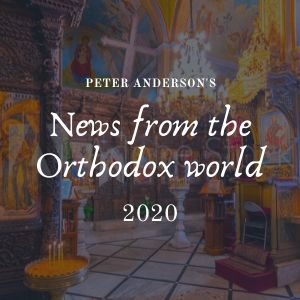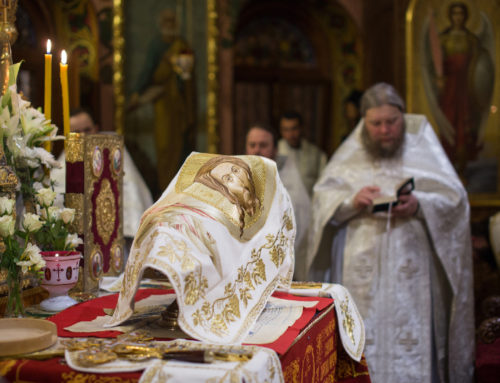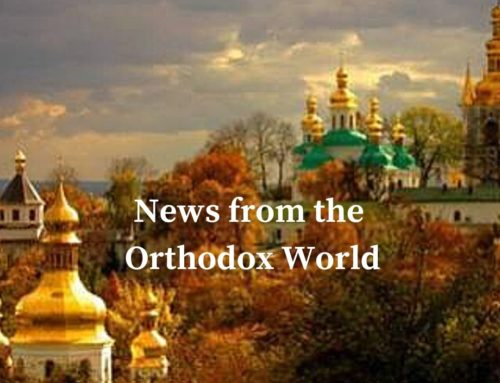Peter Anderson reports from the Orthodox world.
Longstanding reporter of the news from the Eastern Church, Peter Anderson shares our dream or a unified Christianity. His love for Orthodoxy has driven him to this personal mission to share the news of East with the world through his email list. The Urbi et Orbi Foundation is proud to share his efforts and his insights with you.

Today (Wednesday) the Romanian Patriarchate issued a new set of instructions relating to precautionary measures to be taken in view of the Covid pandemic. https://basilica.ro/noi-indrumari-bisericesti-care-se-aplica-din-data-de-17-iunie-2020/ These instructions were developed “in consultation with competent state authorities” and are timed to coincide with the relaxation today of some anti-Covid restrictions by the Romanian government so as to allow the attendance at church services by the faithful. You may recall that on May 15, the Romanian Patriarchate issued a set instructions in anticipation of a relaxation of anti-Covid restrictions. https://basilica.ro/en/romanian-orthodox-churchs-guidelines-for-priests-and-faithful-during-state-of-alert/ In many ways, the new instructions of June 17 are similar to those of May 15.
The instructions of May 15 included the following provision: “Therefore, the Romanian Orthodox Church, according to its centuries-old liturgical tradition, cannot accept, even in times of pandemic, the use of the single-use chalice and spoon for Communion of the faithful during the Divine Liturgy. In this regard, with the approval of the majority of members of the Holy Synod, consulted in writing on May 11, 2020, the manner of general Communion of believers during the Divine Liturgy, during a pandemic, will be decided after June 1, 2020, in consensus with the other Orthodox Churches.” In a letter dated May 19 (the text was never made public), Patriarch Daniel of Romania consulted with the primates of the other Local Orthodox Churches with respect to their views on the manner of communion during the pandemic. Now, in the instructions of June 17, nothing is said about deviating from the traditional way of receiving communion with the common spoon during the Liturgy. Instead, there is only the following sentence which was also found in the instructions of May 15: “Liturgical objects used for divine services will be cleaned before and after the services.” All of this indicates that it is likely that the consultation resulted in an affirmation of the traditional way of receiving communion. As did the instructions of May 15, the instructions today do refer to the possibility of “individual communion,” presumably at a time other than the Liturgy.
I have seen no word yet from Constantinople as to the results of the consultation with the primates made by Ecumenical Patriarch Bartholomew on this same subject. https://www.ecupatria.org/2020/06/02/correspondence-of-the-ecumenical-patriarch-with-primates-of-other-local-orthodox-churches-regarding-the-way-of-distribution-of-the-eucharist/#more-1390 (English text of the letter) As the letter was made public by Constantinople, presumably there will be some public announcement of the results of the consultation. However, a clue as to what might be forthcoming may be contained in an announcement made by the Ecumenical Patriarchate’s Metropolis of Chicago on June 3. https://chicago.goarch.org/-/the-divine-liturgy-rubric The announcement is emphatic that the “manner in which the Holy Eucharist is distributed, however, will not change.” With respect to the faithful who are apprehensive about receiving communion during the pandemic, the clergy “are to shepherd and slowly teach the faithful that the Life-giving Body and Blood of our Lord Jesus Christ never leads to one’s sickness or death.”
On Sunday, Patriarch Kirill dedicated the new massive cathedral of the Russian armed forces. https://orthochristian.com/131896.html A 3-hour video showing the consecration, the liturgy, and the Patriarch’s address to the formations of military in the square in front of the cathedral can be viewed at https://www.youtube.com/watch?tim e_continue=57&v=9Q2vhf72e2U&feature=emb_logo As can be seen from the video, the dark colors of the cathedral seem to reflect a military motif. Consistent with that motif, the Patriarch wore tan vestments. After the service, the Patriarch announced that he had decided to assume the duties of the chief priest of the cathedral. https://tass.ru/obschestvo/8719345 Although President Putin did not attend the service, it was stated that he intends to visit the cathedral at a later time. https://ria.ru/20200615/1572944088.html As had been previously reported by the media, the images of Stalin, Putin, and Shoigu had disappeared from the mosaics of the cathedral. During the service, less than a dozen people (all civilians) received communion. From the video, it appeared to me that they received communion in the traditional manner and that the common spoon was not placed in an alcohol solution after each reception as had earlier been indicated would be true for the Moscow diocese.
Defense Minister and General of the Army Sergei Shoigu was the chief government representative at the service. Shoigu, who has been defense minister since 2012, is probably the most influential and highly regarded member of the government aside from Putin. Shoigu comes from the Tuva Republic, an area of the Russian Federation where the predominate religion is Tibetan Buddhism. For years, his religious affiliation, if any, was unclear. However, in 2015 he was seen crossing himself. During the service on Sunday, he crossed himself on a number of occasions. An article noted that the other military personnel began crossing themselves at the service once Shoigu had done so. https://www.kommersant.ru/doc/4378880?query=%F5%F0%E0%EC In the video above, one can see the young military troops in formation within the cathedral standing at stiff attention during the first part of the service. Later, they were more relaxed and crossing themselves in unison (see 1:38:20 in the video).
In Montenegro yesterday, President Milo Đukanović announced that the parliamentary elections in that country would probably take place at the end of August or the beginning of September. He also stated that the Serbian Orthodox Church is attempting to exert pressure on the government through its processions and seeks to oust the government in the forthcoming elections. https://www.cdm.me/english/dukanovic-soc-is-manipulating-people-and-wants-to-oust-government/ The last seven days have witnessed continued confrontations between the Church and the government. On June 10, the government demolished the beginning of a construction project to build a residence next to the church of St. Basil of Ostrog near the city of Ulcinj. https://balkaneu.com/montenegro-konak-in-saint-basil-monastery-in-ulcinj-demolished The construction project had begun on May 9 when Metropolitan Amfilohije blessed the cornerstone for the future residence. https://mitropolija.com/2020/05/09/novi-manastir-kod-ulcinja-posvecen-svetom-vasiliju-ostroskom/ From the photos, it appears that by the time of destruction, the concrete slab of the main floor and certain walls below the main floor had been completed, but nothing above the slab of the main floor. There appears to be no dispute that the Church had not obtained a government building permit for the project. Metropolitan Amfilohije subsequently referred to the destruction as an unprecedented crime. https://www.spc.rs/eng/metropolitan_amfilohije_demolition_monastery_st_basil_briska_gora_unprecedented_crime The legal basis for the protest by the Serbian Orthodox Church was subsequently set forth at https://www.spc.rs/sr/saopshtenje_za_javnost_mitropolije_crnogorskoprimorske_37 . The main legal arguments appear to be that there are certain deficiencies in the government paperwork relating to the destruction and that certain other buildings in the past had been constructed without the necessary building permits and have not been demolished.
On June 12, the government of Montenegro announced that it had several days earlier made an offer to Metropolitan Amfilohije that “the Government was ready to suspend the implementation of the Law on Freedom of Religion until the Constitutional Court of Montenegro and the European Court of Human Rights in Strasbourg decide on its legitimacy.” At the same time, the Government “offered and proposed for the next week the continuation of the started negotiations at the expert level” on the new law. https://www.gov.me/en/News/227269/PM-Markovic-We-proposed-to-Metropolitan-Amfilohije-suspension-of-law-application-until-Constitutional-and-European-Court-deliver.html (English) On June 13, the Episcopal Council of the Serbian Orthodox Church in Montenegro issued a long and detailed legal rebuttal to this statement. https://www.spc.rs/eng/press_release_episcopal_council_serbian_orthodox_church_montenegro (English) It rejects as “unconstitutional” the offer to suspend the enforcement of the law but is open to continuing the negotiations at the expert level.
On June 11, the Episcopal Council wrote a letter to the faithful that the Church processions would commence again on Sunday June 14. https://www.spc.rs/eng/statement_episcopal_council_serbian_orthodox_church_montenegro_clergy_and_monkhood_montenegro On Sunday, according to a news report, approximately 5,000 believers gathered in Podgorica, more than 3,000 in Nikšić, and hundreds in Budva and Bar. https://www.spc.rs/eng/thousands_participate_first_protest_processions_montenegro_after_quarantine_lifted The current anti-Covid restrictions in Montenegro limit crowds to 200 persons. On May 25, , Prime Minister Duško Marković stated that Montenegro had become the first European nation without an active Covid case. However, in the last few days there have nine new positive Covid test results in Montenegro. https://www.worldometers.info/coronavirus/country/montenegro/ (see graph of new cases) Today, the legal council of the Episcopal Council issued a press release that argued that the limit of 200 imposed by the Ministry of Health of Montenegro is unlawful. https://mitropolija.com/2020/06/17/pravni-savjet-mcp-ministarstvo-zdravlja-prekoracilo-svoja-zakonska-ovlascenja/
In connection with the processions on Sunday, two priests were detained by prosecutors for up to 72 hours for organizing processions in excess of 200 persons. However, courts ordered their release before the 72 hours had expired. https://www.spc.rs/sr/sloboda_za_sveshtenike_iz_pritvora_pushteni_sveshtenici_mircheta_shljivanchanin_zheljko_tshalitsh It has been reported that the trial of Bishop Joanikije and eight priests for alleged violations of the anti-Covid restrictions in Nikšić on May 12 will be held on June 19. https://orthochristian.com/131652.html
One suspects that the actions of both the government of Montenegro and the Serbian Orthodox Church during these weeks are being done, at least in part, with an eye on their possible effects on the parliamentary elections at the end of this summer.
Peter Anderson, Seattle USA


